Quick Guide to the Seven Churches of Revelation
Introduction to the Seven Churches of Asia
This quick guide to the Seven Churches of Revelation offers a brief introduction to the churches addressed by the apostle John in the Revelation he received while exiled on the island of Patmos. The Revelation of St. John would later become the final book of the Christian New Testament.
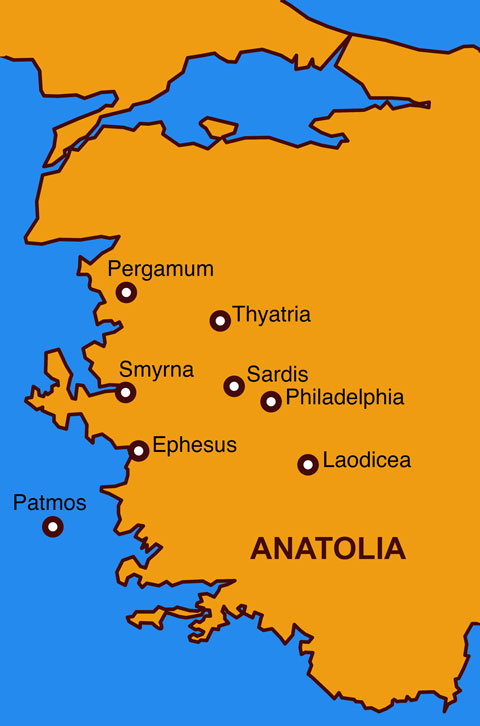
“Write on a scroll what you see and send it to the seven churches: to Ephesus, and to Smyrna, and to Pergamum, and Thyatira, and to Sardis, and to Philadelphia, and to Laodicea.”
Revelation 1:11 (NIV)
The Revelation of St. John was written on the island of Patmos and carried by hand to the churches of Asia. Revelation 1:11 lists the seven churches in the order of what seems a reasonable path to travel between them. Beginning with the church at Ephesus, which was the most important port city close to Patmos, the list proceeds in a clockwise direction up the coast of Aegean Turkiye to Smyrna and Pergamum, then circles east and back around to the south via the inland road, passing through Thyatira, Sardis, Philadelphia and finally Laodicea, where it intersects with the main east/west road leading back towards Ephesus. It is almost as if the Holy Spirit had this circular route in mind when instructing John what to write and how to distribute his message.
The Revelation contains a specific message for each of the seven churches.
The Church in Ephesus
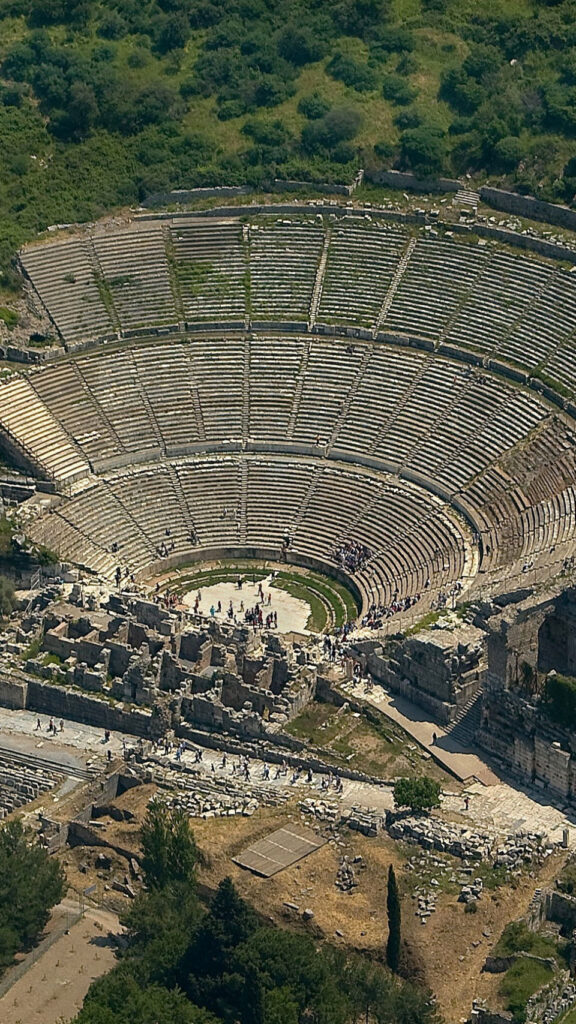
1“To the angel of the church in Ephesus write:
These are the words of him who holds the seven stars in his right hand and walks among the seven golden lampstands. 2 I know your deeds, your hard work and your perseverance. I know that you cannot tolerate wicked people, that you have tested those who claim to be apostles but are not, and have found them false. 3 You have persevered and have endured hardships for my name, and have not grown weary.
4 Yet I hold this against you: You have forsaken the love you had at first. 5 Consider how far you have fallen! Repent and do the things you did at first. If you do not repent, I will come to you and remove your lampstand from its place. 6 But you have this in your favor: You hate the practices of the Nicolaitans, which I also hate.
7 Whoever has ears, let them hear what the Spirit says to the churches. To the one who is victorious, I will give the right to eat from the tree of life, which is in the paradise of God.
First century Ephesus was one of the great seaports of the classical world. Located on the eastern shores of the Aegean Sea, at the mouth of the Cayster River, it was an important center for travel and commerce. Over 150,000 people called Ephesus home. Three major roads led out from Ephesus: one to the north, one to the south, and the most important one to the east towards Babylon via Laodicea.
Paul visited Ephesus on is second missionary journey (52 CE) and evidently started a church there (Acts 18:19).
On Paul’s third missionary journey (A.D. 54-56), Paul spent between two and three years teaching in the city (Acts 19:8-10). He spent his time addressing false doctrines and pagan practices. Paul’s teaching in the rented school of Tyrannus was so successful that those who practiced magic brought their books and burned them as an act of repentance (Acts 19:18-20). During this stay in Ephesus he wrote 1 Corinthians.
As the sale of silver idolatrous images began to fall off, the silversmiths raised an uproar (Acts 19:26-41). Shortly after this dust-up was settled Paul left for Macedonia.
Several months later (A.D. 57) Paul met with the Ephesian elders at Miletus and made his farewell address (Acts 20). Their mutual love is evident as these tenderhearted men weep over what God has done – and they know they will not see Paul again. As Luke records their conversation and prayer it is evident there is increasing maturity in the faith. The picture now is of a church that has been carefully nurtured to the point of vitality.
About a decade later, Paul wrote the letter to the Ephesians commending their faith and love (A.D. 62). A careful reading of this epistle shows that they had done well. They appeared devout in their faith, well organized, and active in gospel work. During these early years they had been growing, expanding and doing the will of God. Jews and Gentiles, from several ethnicities and nationalities, had come together to form “one body” (Eph 2:16). They were multiethnic as well as diverse in their socioeconomic make-up. Paul commends their sincerity in the final sentence of his letter: “Grace be with all those who love our Lord Jesus Christ with incorruptible love” (Eph 6:24).
The Church in Smyrna
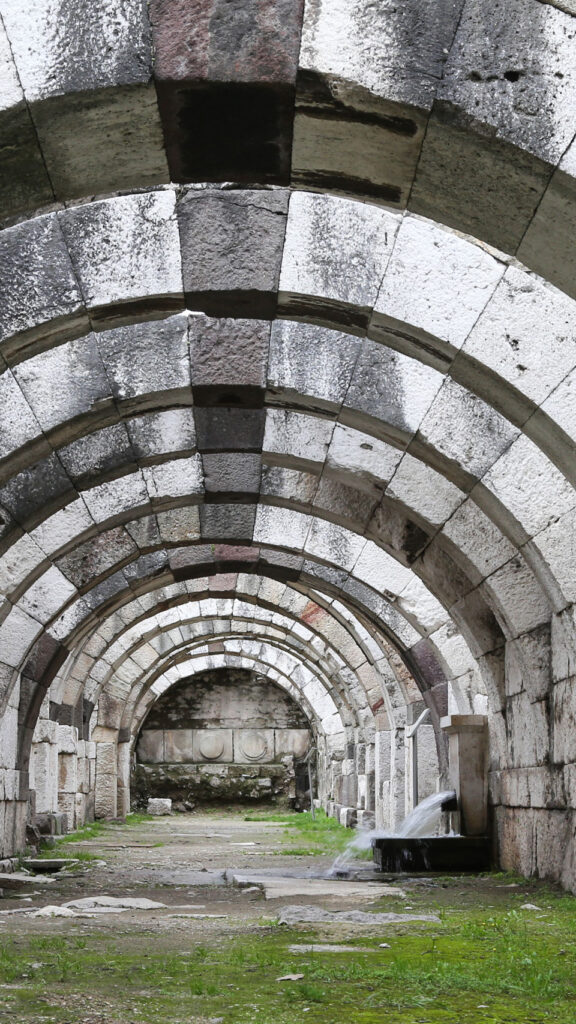
8 “To the angel of the church in Smyrna write:
These are the words of him who is the First and the Last, who died and came to life again. 9 I know your afflictions and your poverty—yet you are rich! I know about the slander of those who say they are Jews and are not, but are a synagogue of Satan. 10 Do not be afraid of what you are about to suffer. I tell you, the devil will put some of you in prison to test you, and you will suffer persecution for ten days. Be faithful, even to the point of death, and I will give you life as your victor’s crown.
11 Whoever has ears, let them hear what the Spirit says to the churches. The one who is victorious will not be hurt at all by the second death.
Located 56 kilometers (35 miles) north of Ephesus on the main coastal road, Smyrna was also one of the principal cities of Roman Asia. Blessed with an advantageous geographical position and a good port, Smyrna flourished and grew rich during the Roman era in part from trade in myrrh, a gum resin used in perfume, incense and medicine. Myrrh was also used as an ingredient in Jewish anointing oil.
Smyrna was a religious city boasting a great number of temples, including those dedicated to Zeus, Cybele, Aphrodite, Herakles and Dyonisius. Ancient Smyrna even built a temple to Roma, deifying the city in a bid for aid against Asian rivals. In the 1st century CE it was an obvious choice to be named temple warden for the Roman Imperial Cult, including new temples and statues built for Emperors Tiberius, Domitian, Trajan and later Hadrian during the 2nd century CE.
Little remains today of New Testament era Smyrna, so our knowledge depends mostly on literary sources. By all accounts it was magnificent. Strabo described Smyrna as the most beautiful of city along the Aegean coast. The inscription “pearl of Asia” survives on the entrance to the western stoa of the agora. 2nd century CE coins bear the claim, “first in Asia in beauty and size.” Indeed, the full phrase, “First in Asia in beauty and size, and the most brilliant, and Metropolis of Asia, and thrice Temple Warden of the Augusti, according to the decrees of the most sacred Senate, and ornament of Ionia” survives in many inscriptions about the city.
The reference to Jesus as the one “who died, and came to life again” may have been used in the letter for this particular city due to its rebuilding and resurgence during the Roman era (Rev 2:8). In the letter to Smyrna, John remarks that the Christians in Smyrna have experienced oppression and that they are “poor” but also rich, alluding to the reputation of the city as pagan and wealthy (Rev 2:8-9).
The letter mentions blasphemy by Jews who are actually part of a “synagogue of Satan,” and in the future that some of the Christians will be thrown into prison, but that they must be faithful until death (Rev 2:9-10). Written during the time of Domitian and Christian persecution, the church at Smyrna faced even more opposition than most, due to the strong influence of emperor worship in the city, which at that time was required by law and punishable by imprisonment or death. An interpretation of the reference to the “synagogue of Satan” is tentative, but it may refer to Jews who not only opposed Christianity, but also participated in the imperial cult.
Like many other cities of Asia Minor, there was a significant community of Jews, including at least one synagogue (Rev 2:9). Unfortunately, many of these Jews were fiercely opposed to Christianity, and just as Paul and his friends had been opposed and attacked by Jews in other cities, the Christians in Smyrna also faced persecution from not only the pagans, but the Jews. Polycarp, who had known and been taught by John the Apostle, was martyred in Smyrna at the instigation of Jews in about 156 CE. The 2nd century Church bishop and apologist Irenaeus was born in Smyrna, and knew Polycarp in his youth
The Church in Pergamum
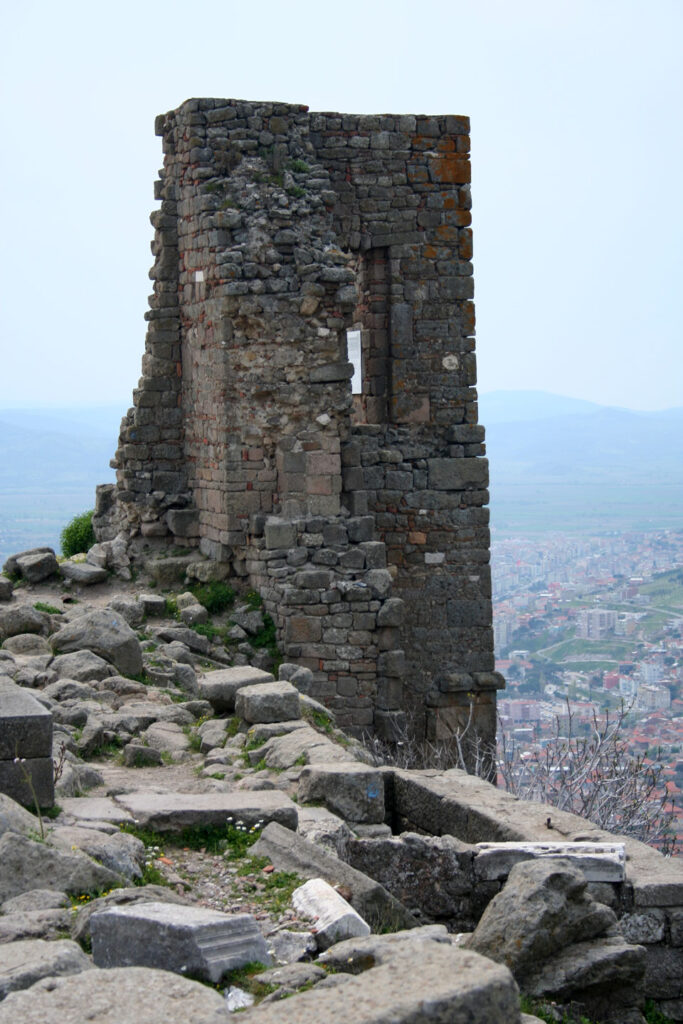
12 “To the angel of the church in Pergamum write:
These are the words of him who has the sharp, double-edged sword. 13 I know where you live—where Satan has his throne. Yet you remain true to my name. You did not renounce your faith in me, not even in the days of Antipas, my faithful witness, who was put to death in your city—where Satan lives.
14 Nevertheless, I have a few things against you: There are some among you who hold to the teaching of Balaam, who taught Balak to entice the Israelites to sin so that they ate food sacrificed to idols and committed sexual immorality. 15 Likewise, you also have those who hold to the teaching of the Nicolaitans. 16 Repent therefore! Otherwise, I will soon come to you and will fight against them with the sword of my mouth.
17 Whoever has ears, let them hear what the Spirit says to the churches. To the one who is victorious, I will give some of the hidden manna. I will also give that person a white stone with a new name written on it, known only to the one who receives it.
Pergamum, located 16 miles (26 kilometers) inland from the coast, was once the capital of the Roman province of Asia. Perched upon a mesa 335 meters (1099 feet) high, the temples of the upper city were visible from a great distance away in the valley below. Militarily, it was practically impregnable. In his Natural History (c. 79 CE), Pliny the Elder referred to Pergamum as the most important city of Asia.
An impressive 2nd century BCE alter, believed to have been dedicated to Zeus and possibly Athena, was one of the important features of the 1st century CE acropolis. Boasting a footprint 112X118 feet (34X36 meters) in size, the glistening white marble structure would have stood out against the sky and been visible from miles away. It’s throne-like shape may have been the inspiration for John’s reference to “where Satan has his throne” (Rev 2:13).
According to christian tradition, Antipas (Rev 2:13), one of the earliest recorded Christian martyrs, was slain in Pergamum in 92 CE.
Pergamum was a prominent center of learning, with a library second only to the great library of Alexandria. Plutarch numbered the library collection at 200,000 scrolls. Vitruvius wrote that the Attalid Kings, “impelled by their delight in literature established for a general perusal a fine library at Pergamus.”
The theatre, built into the slope of the mesa, was the steepest in the ancient world. It sat 10,000 spectators in 70 rows of seats.
The Church in Thyatira
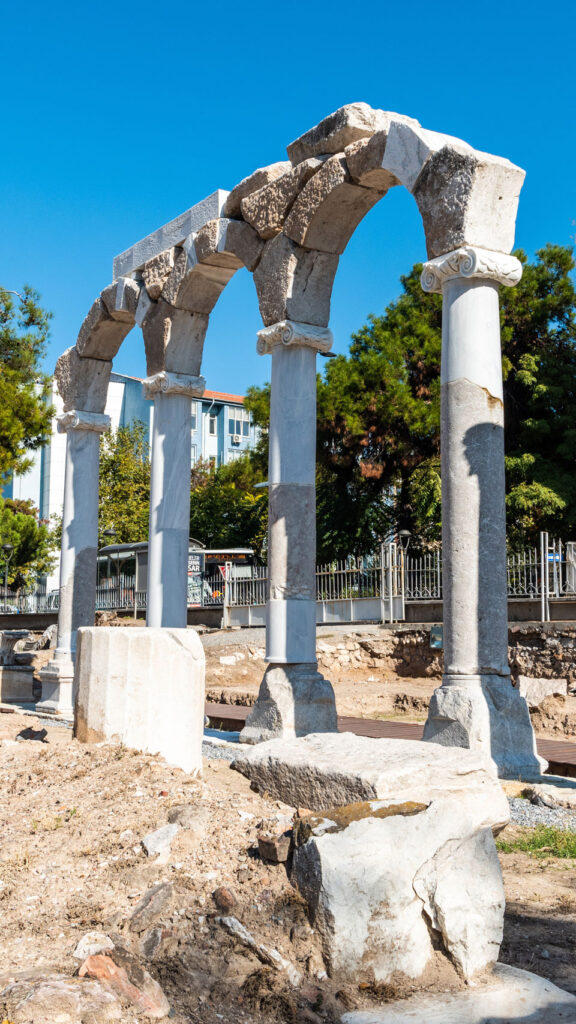
18 “To the angel of the church in Thyatira write:
These are the words of the Son of God, whose eyes are like blazing fire and whose feet are like burnished bronze. 19 I know your deeds, your love and faith, your service and perseverance, and that you are now doing more than you did at first.
20 Nevertheless, I have this against you: You tolerate that woman Jezebel, who calls herself a prophet. By her teaching she misleads my servants into sexual immorality and the eating of food sacrificed to idols. 21 I have given her time to repent of her immorality, but she is unwilling. 22 So I will cast her on a bed of suffering, and I will make those who commit adultery with her suffer intensely, unless they repent of her ways. 23 I will strike her children dead. Then all the churches will know that I am he who searches hearts and minds, and I will repay each of you according to your deeds.
24 Now I say to the rest of you in Thyatira, to you who do not hold to her teaching and have not learned Satan’s so-called deep secrets, ‘I will not impose any other burden on you, 25 except to hold on to what you have until I come.’
26 To the one who is victorious and does my will to the end, I will give authority over the nations— 27 that one ‘will rule them with an iron scepter and will dash them to pieces like pottery—just as I have received authority from my Father. 28 I will also give that one the morning star. 29 Whoever has ears, let them hear what the Spirit says to the churches.
Thyatira was an inland textile industry center located about 50 miles (80 kilometers) east of the Aegean coast. Inscriptions recovered from the site display a wide variety of craft guilds operating in the city.
1st Century CE Thyatira was well established in the production of purple dye, an expensive product which must have made its guild members prosperous. Lydia, Paul’s first convert in Macedonia, is described as a woman from Thyatira who sold purple goods (Acts 16:14).
The best purple dye was made from murex shells, which are frequently found along the shore of the Eastern Mediterranean. The Phoenicians discovered how to make the purple dye, and the profitable technology quickly spread throughout the ancient world, including, apparently, all the way to Thyatira.
According to Revelation a woman called Jezebel, a self proclaimed prophet, led the Christians of the city into sin (Rev 2:20). Some scholars think this use of Jezebel as an epithet might be a direct reference to the Old Testament character of the same name, used to emphasize the same apostasy described in the book of Kings. It is worth noting that the original Jezebel was also a Princess of Tyre, the great Phoenician city where purple dye was discovered. The connection would not have been missed by the guild members in Thyatira.
The Church in Sardis
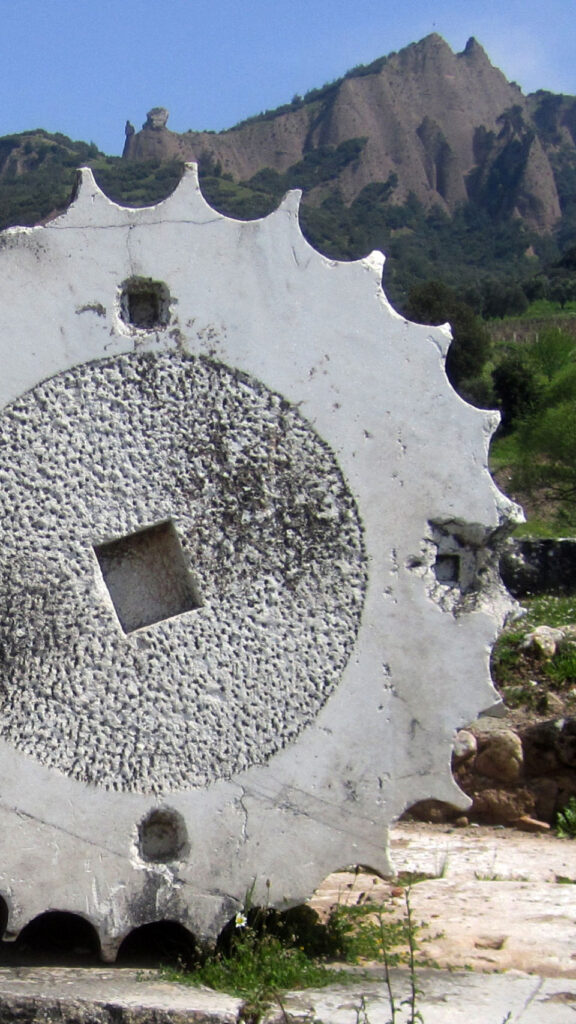
1“To the angel of the church in Sardis write:
These are the words of him who holds the seven spirits of God and the seven stars. I know your deeds; you have a reputation of being alive, but you are dead. 2 Wake up! Strengthen what remains and is about to die, for I have found your deeds unfinished in the sight of my God. 3 Remember, therefore, what you have received and heard; hold it fast, and repent. But if you do not wake up, I will come like a thief, and you will not know at what time I will come to you.
4 Yet you have a few people in Sardis who have not soiled their clothes. They will walk with me, dressed in white, for they are worthy. 5 The one who is victorious will, like them, be dressed in white. I will never blot out the name of that person from the book of life, but will acknowledge that name before my Father and his angels. 6 Whoever has ears, let them hear what the Spirit says to the churches.
About 30 miles south of Thyatira, located at the cross roads of some of the most important trading roads of the classical era. As a result of its fortunate position, the city grew wealthy as a main city of the Lydian empire. It was at Sardis that the first coins were minted.
The Acropolis of Sardis was a walled fortress 800 feet above the city, surrounded by rock walls on three sides. It was almost impregnable, and was breached by invaders on only two occasions. In both cases sleeping guards were to blame.
As with other cities, Sardis contained many temples to Greek and Roman gods, including a temple to Diana that was intended to rival the wonder at Ephesus.
The Church in Philadelphia
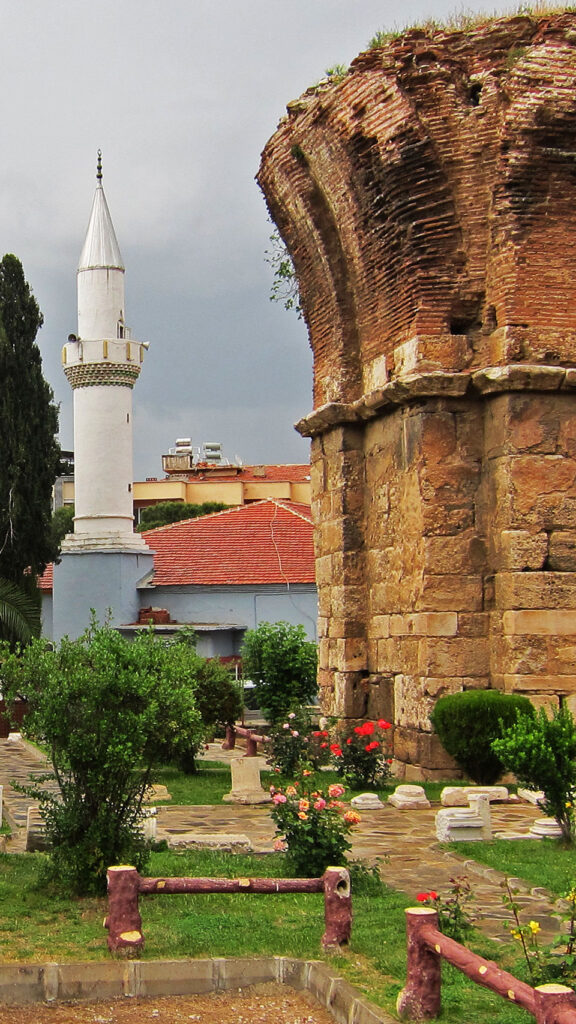
7“To the angel of the church in Philadelphia write:
These are the words of him who is holy and true, who holds the key of David. What he opens no one can shut, and what he shuts no one can open. 8 I know your deeds. See, I have placed before you an open door that no one can shut. I know that you have little strength, yet you have kept my word and have not denied my name. 9 I will make those who are of the synagogue of Satan, who claim to be Jews though they are not, but are liars—I will make them come and fall down at your feet and acknowledge that I have loved you. 10 Since you have kept my command to endure patiently, I will also keep you from the hour of trial that is going to come on the whole world to test the inhabitants of the earth.
11 I am coming soon. Hold on to what you have, so that no one will take your crown. 12 The one who is victorious I will make a pillar in the temple of my God. Never again will they leave it. I will write on them the name of my God and the name of the city of my God, the new Jerusalem, which is coming down out of heaven from my God; and I will also write on them my new name. 13 Whoever has ears, let them hear what the Spirit says to the churches.
Philadelphia was established in 198 BCE by King Eumenes II of Pergamum, and was named for love of his brother and ultimate successor, Attalus II. It was perhaps one of the earliest cities to bear the name Philadelphia (city of brotherly love).
Not much is known about Roman era Philadelphia besides a history of frequent earthquakes. Strabo wrote that it was “ever subject to earthquakes” and that “incessantly the walls of houses are cracked.” John’s promise to make the victorious one “a pillar in the temple of my God” (Rev 3:12) may be a nod to survival in an earthquake prone city. Structural pillars up to 5 meters around supported buildings to help them withstand earthquakes. Likewise, the believer who withstands trials and temptations is the one who perseveres to win the crown of life (Rev 2:10).
Remains of the antique city lie beneath the modern Turkish city of Alasehir, and have never been excavated.
The Church in Laodicea
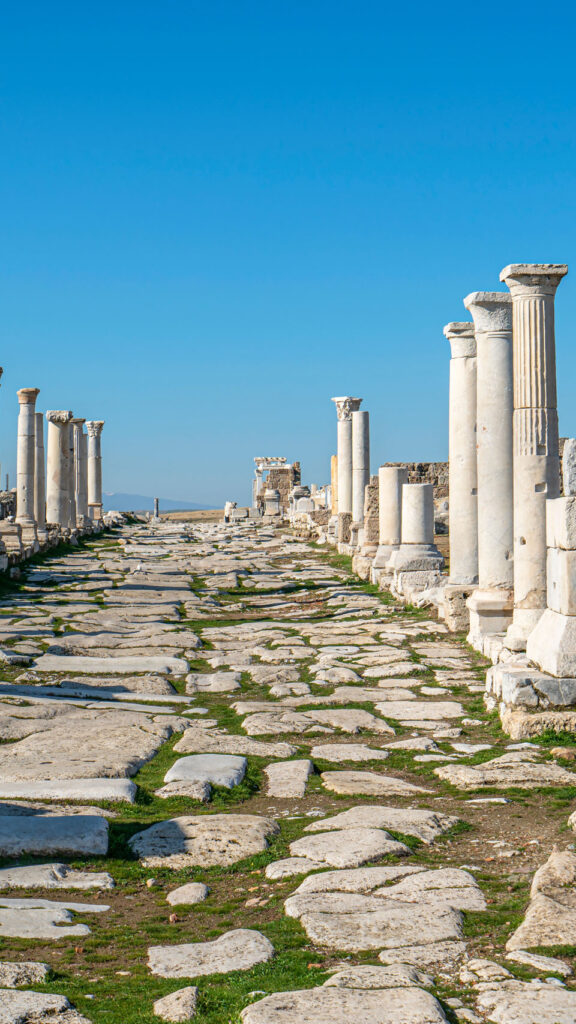
14“To the angel of the church in Laodicea write:
These are the words of the Amen, the faithful and true witness, the ruler of God’s creation. 15 I know your deeds, that you are neither cold nor hot. I wish you were either one or the other! 16 So, because you are lukewarm—neither hot nor cold—I am about to spit you out of my mouth. 17 You say, ‘I am rich; I have acquired wealth and do not need a thing.’ But you do not realize that you are wretched, pitiful, poor, blind and naked. 18 I counsel you to buy from me gold refined in the fire, so you can become rich; and white clothes to wear, so you can cover your shameful nakedness; and salve to put on your eyes, so you can see.
19 Those whom I love I rebuke and discipline. So be earnest and repent. 20 Here I am! I stand at the door and knock. If anyone hears my voice and opens the door, I will come in and eat with that person, and they with me.
21 To the one who is victorious, I will give the right to sit with me on my throne, just as I was victorious and sat down with my Father on his throne. 22 Whoever has ears, let them hear what the Spirit says to the churches.”
1st century CE Laodicea was a prosperous city on the main road between the Aegean Sea and the Levant, located about 100 miles (160 Kilometers) east of Ephesus. It was located in close proximity to the biblical cities of Colossae and Heirapolis, with which it seems to have been connected.
Strabo attributes the wealth of Laodicea to rich soil around the city, which would have supported considerable agricultural production. Its advantageous position on a major trade route probably contributed as well.
The measure of its development can be marked by requests for assistance after earthquakes. When Laodicea was destroyed in 27 BCE, during the reign of Augustus, the Emperor assisted the reconstruction. In 17 CE it was damaged a second time, and the Emperor Tiberius helped with repairs. But by 60 CE, the city rebuilt without accepting any aid. The hubris of rapid wealth accumulation may be reflected in them boasting, “I am rich; I have acquired wealth and do not need a thing” (Rev 3:17).
The imagery of hot, cold and lukewarm water (Rev 3:15-16) is also apropos. Waterworks were prominent in Laodicea. The mineral hot springs of Heirapolis were but six miles away and could be seen from the center of the city. Surely every inhabitant understood the healing properties of a long, hot soak. Likewise an impressive aqueduct carried cold water into the city, and a bath has been excavated near the center. In fact, both hot and cold water were considered to have medicinal properties. Lukewarm water, on the other hand, was thought to induce vomiting. Indeed, the verb spit in the phrase “I am about to spit you out of my mouth” (Rev 3:16) is sometimes translated vomit.







